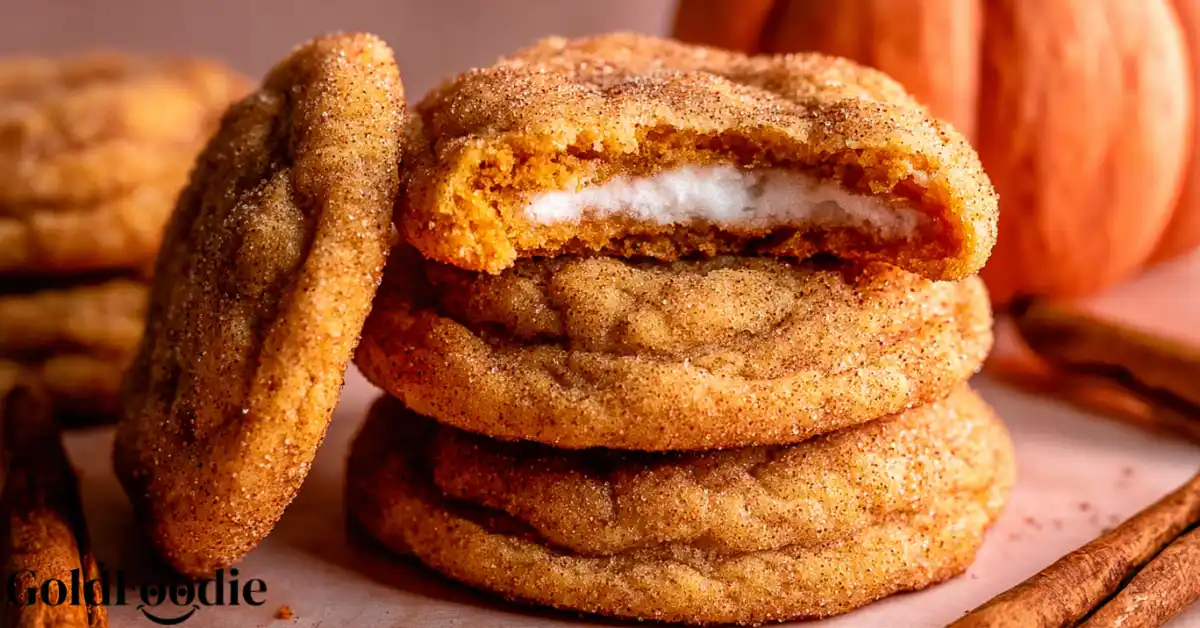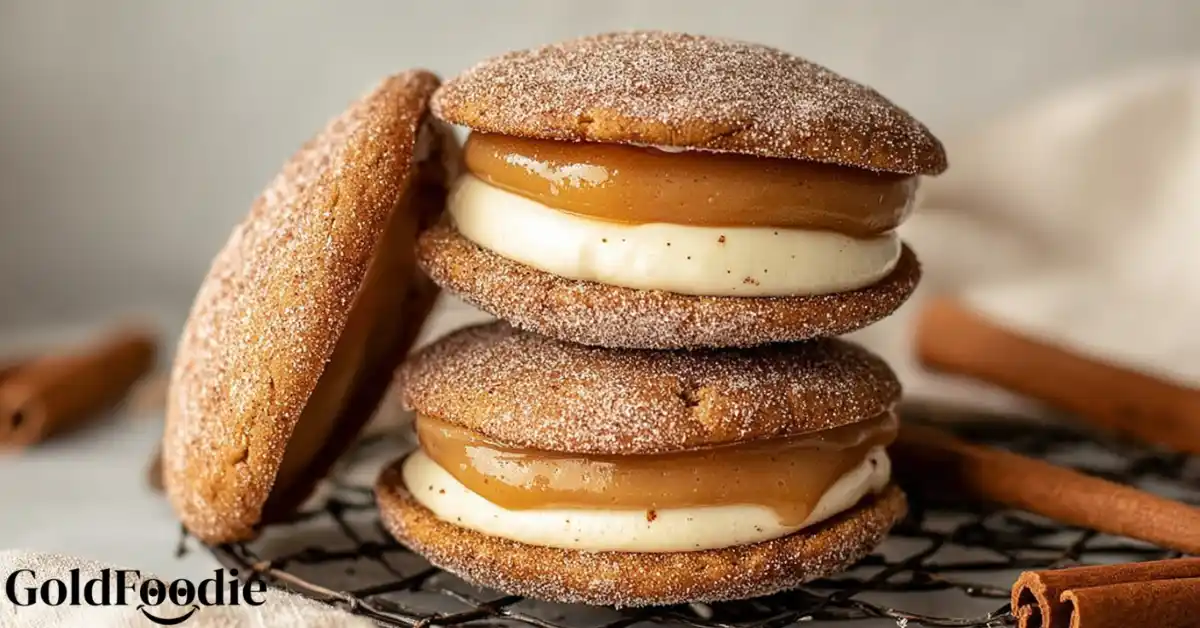If you’re searching for a healthy breakfast that feels like dessert, this recipe will hit the spot. Carrot cake with chia seeds brings the best of both worlds. It satisfies your sweet tooth while giving your body the nutrients it needs to start the day strong.
This article is your complete guide to making the ultimate high-protein carrot cake chia pudding. Whether you follow a plant-based diet, want to avoid supplements, or simply need a filling breakfast that tastes amazing, this is the only recipe you’ll need.
Table of Contents
Why This Will Be Your New Favorite Healthy Breakfast
- Packed with Protein
This carrot cake with chia recipe is built to keep you full for hours. With four different ways to boost protein, you can adjust it to fit your goals. - Tastes Like Dessert
You get all the cozy carrot cake flavor thanks to cinnamon, nutmeg, and natural sweetness. It feels like a treat without the guilt. - Perfect for Meal Prep
Make it once and enjoy all week. This pudding stores well and works great as a grab-and-go breakfast or snack. - Nutrient-Dense and Healthy
Every spoonful supports your health. The chia seeds, walnuts, and carrots deliver fiber, healthy fats, and important micronutrients that support digestion, energy, and overall wellness.
⭐️⭐️⭐️⭐️⭐️
“Chia seeds are rich in fiber, protein, omega‑3s and antioxidants. They help support digestion, reduce inflammation and boost heart health.” – Registered dietitian Daniela Novotny, Senior Instructor of Nutrition and Dietetics, Missouri State University
You’ll Also Love
➤
➤
➤
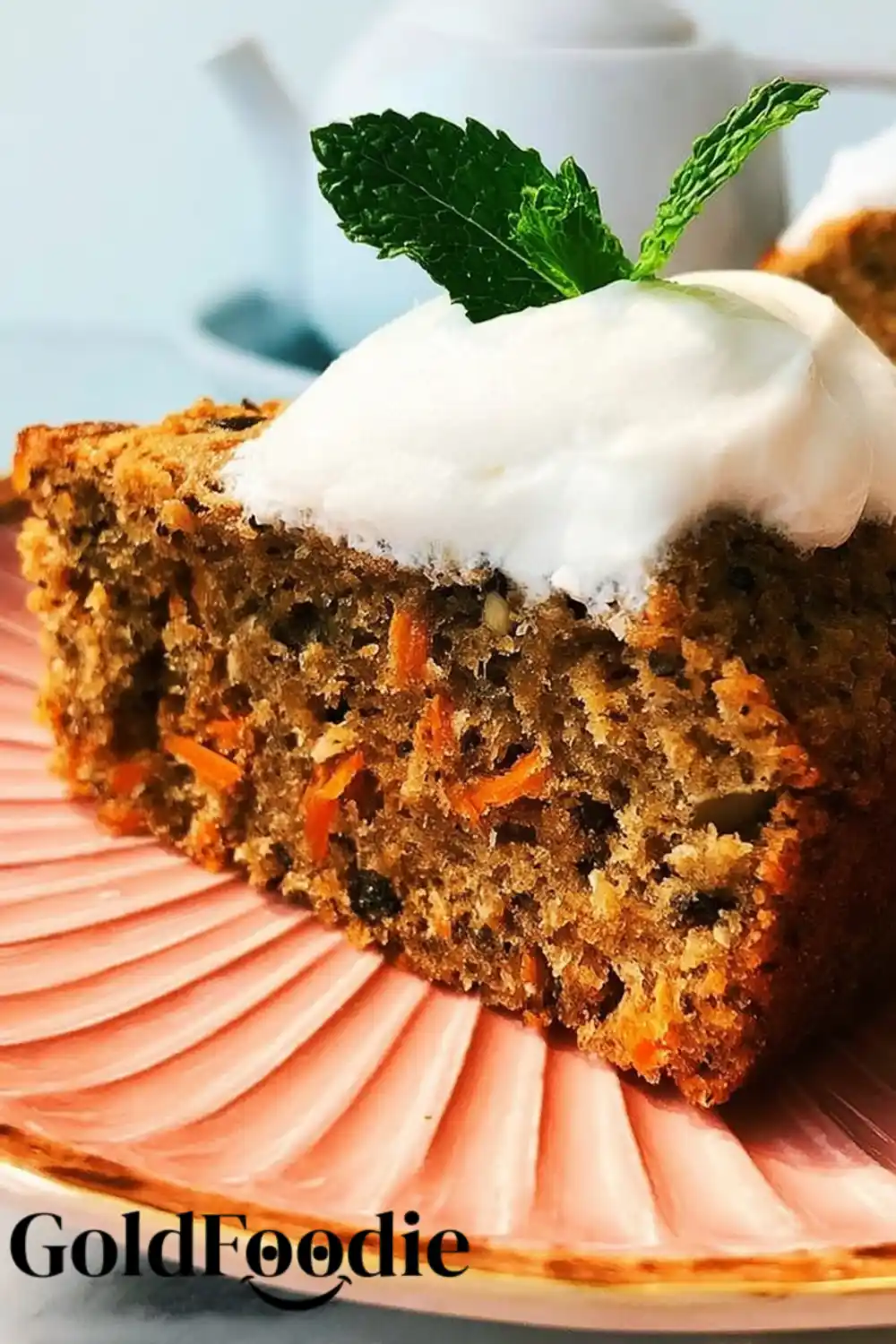
Ingredients You’ll Need (and Smart Substitutions)
To make this protein-rich carrot cake with chia, you’ll need simple, wholesome ingredients. Here’s everything broken down by function so you can swap or adjust as needed.
For the Base:
- 2 tablespoons chia seeds
- ½ cup boiling water
- ½ cup plant-based milk such as almond, soy, or oat
- ¼ cup olive oil
- ½ cup unsweetened applesauce
- 1 tablespoon lemon juice
- 1 cup grated carrots
For Sweetness and Structure:
- 1 cup soft brown sugar
- 2 cups self-raising flour
- 1 teaspoon baking soda
- ¼ teaspoon salt
For Flavor:
- 1 teaspoon ground cinnamon
- 1 teaspoon ground nutmeg
For Texture and Crunch:
- 1 cup chopped walnuts
Smart Swaps:
- Swap olive oil for melted coconut oil if you prefer a sweeter flavor.
- Replace brown sugar with coconut sugar or maple syrup for a refined sugar-free option.
- Use gluten-free flour to make this recipe suitable for gluten-sensitive diets.
- Walnuts can be substituted with pecans or sunflower seeds for a nut-free version.
This ingredient list makes the perfect foundation for a moist and flavorful carrot cake with chia that works for many dietary needs.
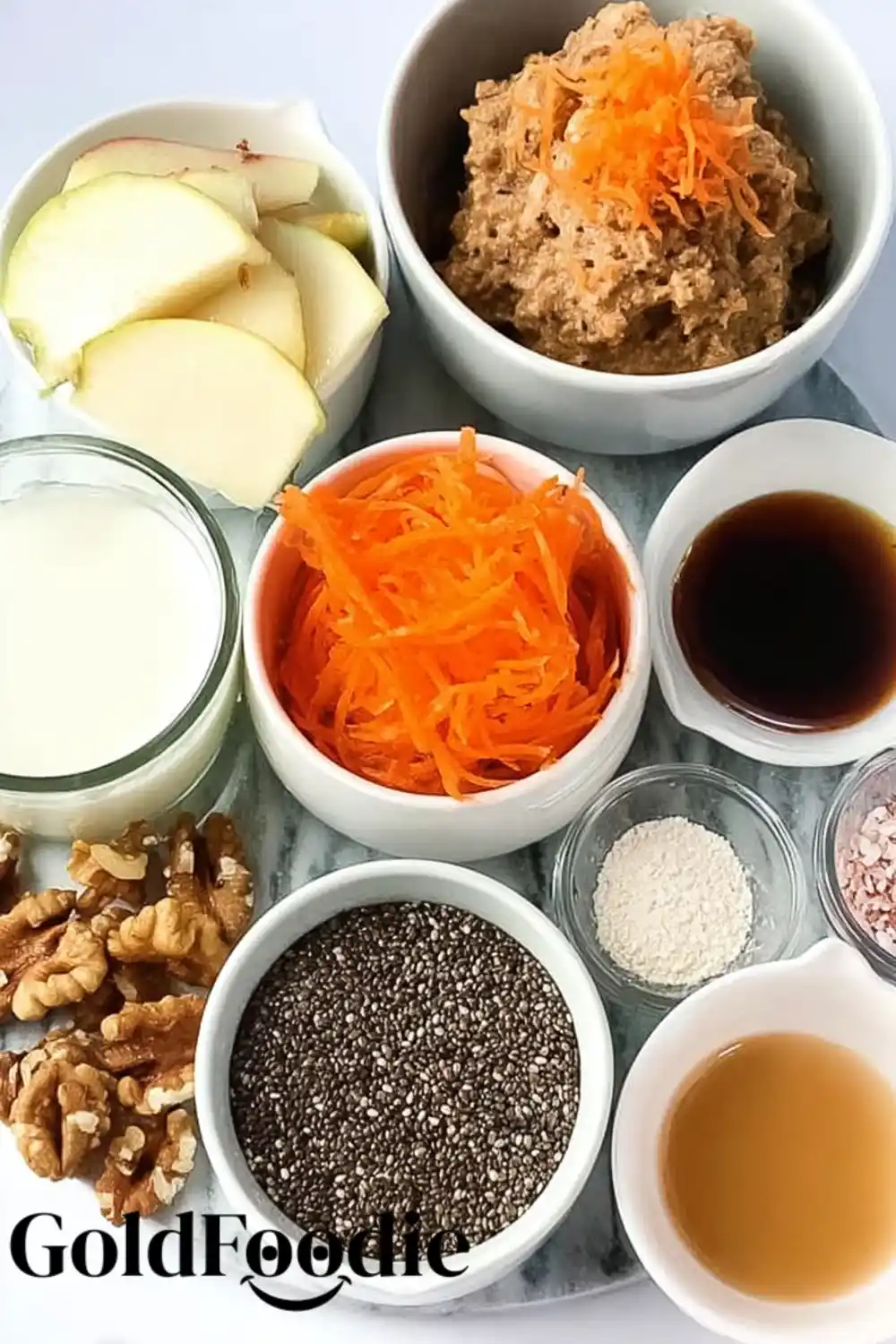
How to Make Carrot Cake with Chia Pudding
This recipe is easy to follow and comes together with just a few steps. Before starting, preheat your oven to 180°C and prepare your cake tin by greasing it and lining it with baking paper.
Step 1: Soak the Chia Seeds
Place the chia seeds in a large mixing bowl. Add the boiling water and stir well. Let them sit for five minutes so they can absorb the liquid and create a gel-like texture.
Step 2: Prepare the Dry Ingredients
In a separate bowl, sift the self-raising flour, cinnamon, nutmeg, baking soda, and salt. Add the brown sugar and stir to combine. If the sugar has lumps, break them up with your fingers or a spoon. Add the chopped walnuts to this mix and stir again.
Step 3: Combine the Wet Ingredients
To the bowl of soaked chia seeds, add the plant-based milk, olive oil, applesauce, lemon juice, and grated carrots. Stir until well combined.
Step 4: Mix Everything Together
Slowly pour the dry ingredients into the wet mixture. Use a spatula or wooden spoon to mix gently until no dry spots remain. Do not overmix, as that can affect the final texture.
Step 5: Bake
Pour the batter into your prepared cake tin. Smooth out the top using the back of a spoon. Place the tin in the preheated oven and bake for about 45 minutes. The cake is done when a toothpick or skewer inserted in the center comes out clean.
Step 6: Cool and Serve
Let the cake cool in the tin for at least 10 minutes. Then carefully turn it out onto a wire rack to cool completely.
Equipment Needed
★ Large Mixing Bowl
★ Sifter
★ Grater
★ Cooling Rack
★ Oven
★ Baking Paper
★ Cake Tin (large size)
Serving Tip
Serve plain or top with a whipped coconut cream frosting. If frosted, store the cake in the fridge. If unfrosted, keep it in an airtight container at room temperature. Refrigerate extra frosting and use as needed.
This method keeps the texture light and moist while allowing the flavors of the carrot cake with chia to shine.
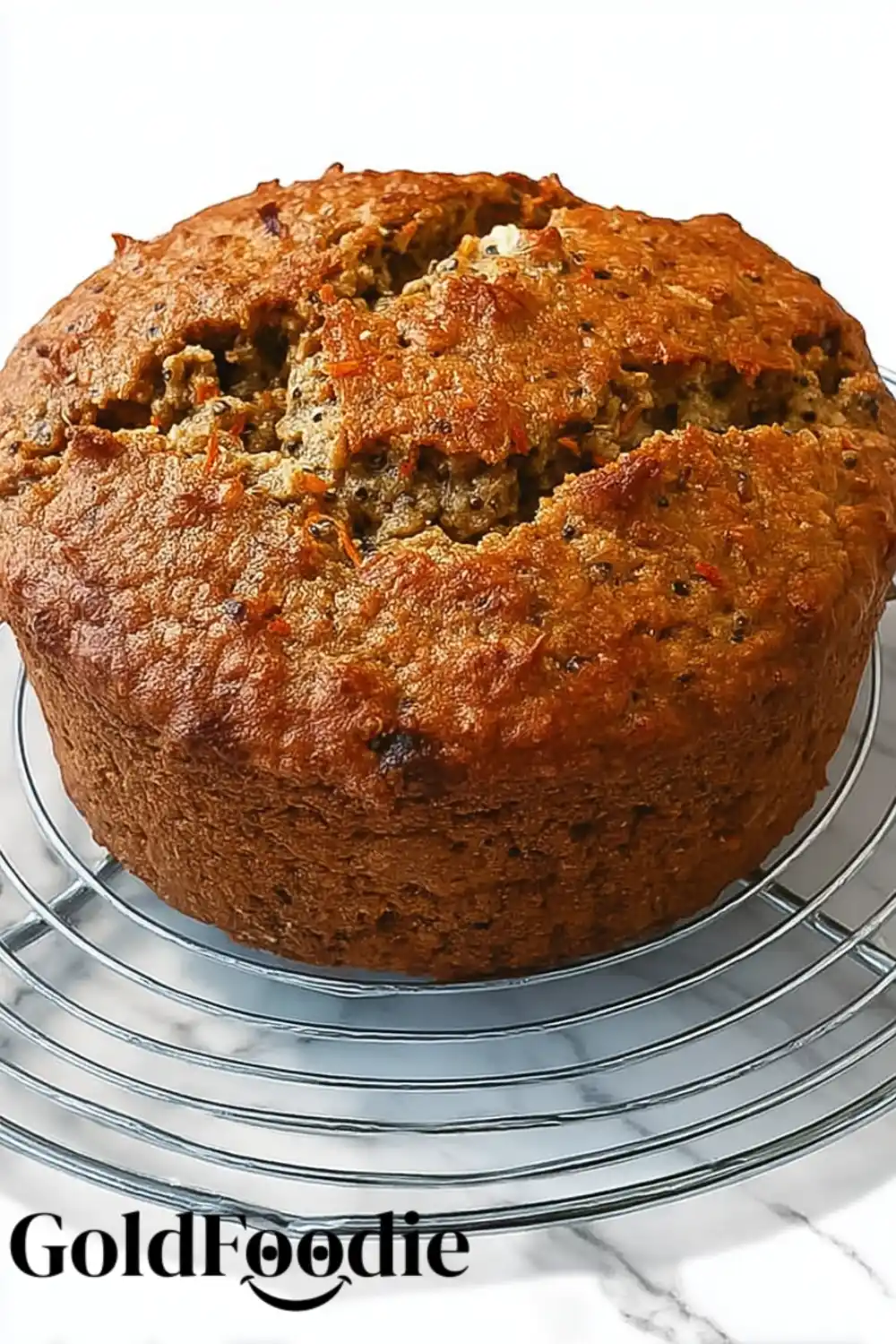
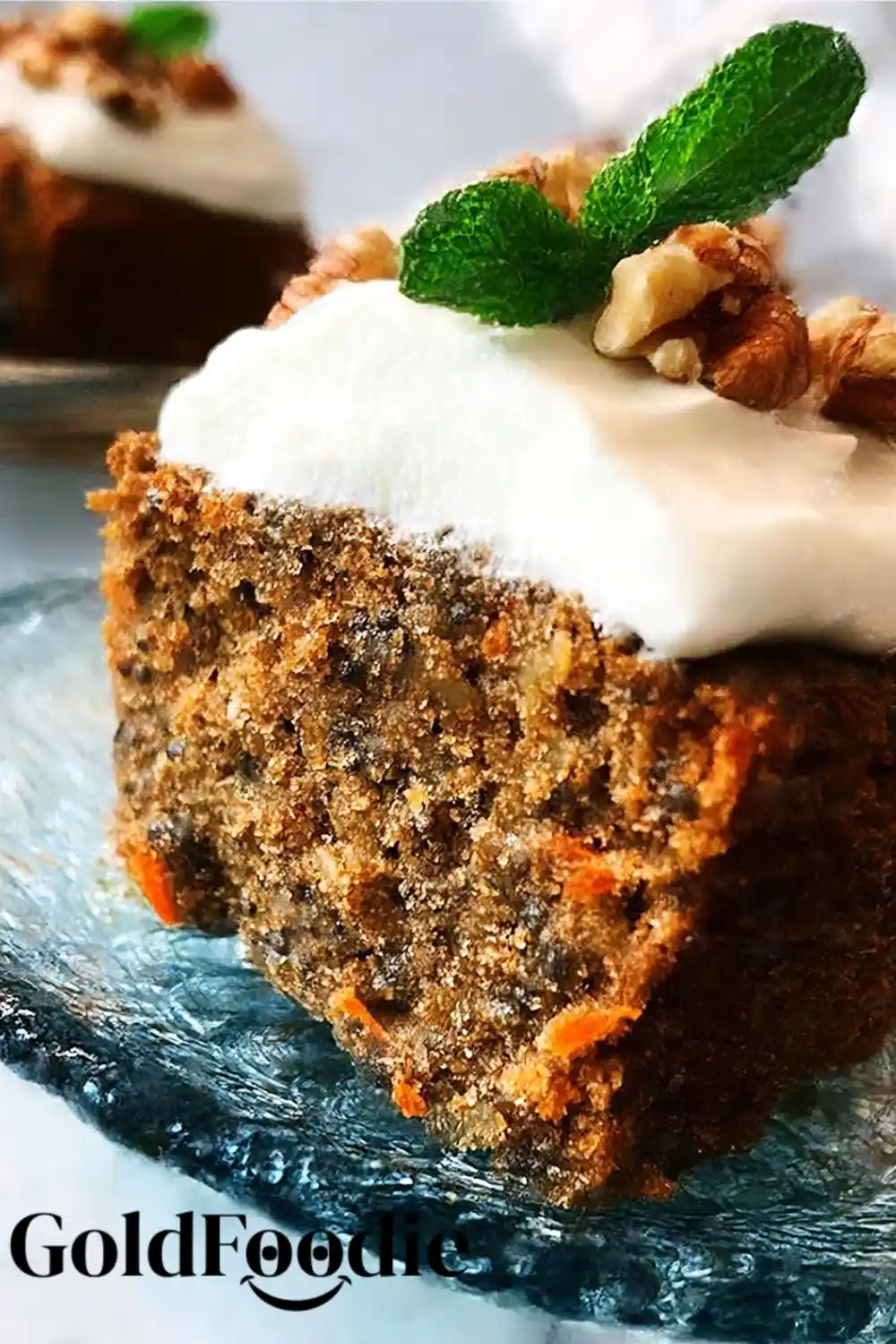
Carrot Cake with Chia Pudding (High Protein)
Ingredients
Method
- Preheat oven to 180°C (356°F). Grease and line a cake tin with baking paper.
- Place chia seeds in a mixing bowl. Add boiling water, stir well, and let sit for 5 minutes to form a gel.
- In another bowl, sift together flour, cinnamon, nutmeg, baking soda, and salt. Add brown sugar and break up lumps. Stir in chopped walnuts.
- To the soaked chia, add plant milk, olive oil, applesauce, lemon juice, and grated carrots. Mix until combined.
- Gently combine wet and dry ingredients using a spatula. Mix until no dry spots remain, but do not overmix.
- Pour batter into prepared tin. Smooth the top and bake for 45 minutes or until a toothpick comes out clean.
- Let cool in tin for 10 minutes, then transfer to a wire rack to cool completely.
Notes
Nutrition Facts (Per Serving)
Calories: 313 | Total Fat: 14g | Saturated Fat: 2g | Polyunsaturated Fat: 6g | Monounsaturated Fat: 5g | Sodium: 201mg | Potassium: 158mg | Carbohydrates: 44g | Fiber: 2g | Sugars: 24g | Protein: 5g | Vitamin A: 2146 IU | Vitamin C: 1mg | Calcium: 57mg | Iron: 1mg Nutrition Disclaimer Nutritional information provided is an estimate and may vary based on the products and brands you use. Calculate the actual nutrition values using your preferred nutrition calculator and the exact ingredients you choose.Choose Your Protein Boost: A Head-to-Head Comparison
The beauty of this carrot cake with chia recipe lies in its flexibility. You can boost the protein to match your dietary needs without changing the taste or texture too much. Below are the best options to choose from.
The Dairy Method (For the Creamiest Texture)
Blended Cottage Cheese
This option gives your pudding an ultra-creamy texture with a mild tang. It adds about 12 grams of protein per half cup. It also thickens the mix naturally.
Greek Yogurt
Greek yogurt provides a similar creaminess with a slightly stronger flavor. It adds around 10 grams of protein and works well if you enjoy a tangy twist.
The Plant-Based Method (Vegan and Dairy-Free)
Vanilla Protein Powder
This is the fastest way to increase protein. One scoop adds 20 to 25 grams depending on the brand. Choose unsweetened or natural flavors to keep the taste balanced.
Cooked Quinoa and Hemp Hearts
This is a supplement-free approach. Cooked quinoa adds texture and a nutty flavor, while hemp hearts bring in healthy fats and plant-based protein.
Protein Comparison Chart
| Protein Source (per serving) | Approx. Protein Added | Texture and Flavor Notes |
| ½ cup Blended Cottage Cheese | +12g | Ultra-creamy and mild tang |
| ½ cup Greek Yogurt | +10g | Creamy with a tangy kick |
| 1 scoop Protein Powder | +20 to 25g | Flavor depends on brand and type |
| ¼ cup Cooked Quinoa | +2g | Slight crunch with a nutty finish |
Pick the method that works best for your lifestyle. Whether you prefer dairy or want a vegan option, this carrot cake with chia pudding adapts easily.
Nutritionist’s Notes: The “Why” Behind the Health
This carrot cake with chia pudding is more than just a tasty treat. Every ingredient plays a role in supporting your health.
Chia Seeds
Chia seeds provide fiber that supports digestion and promotes fullness. They also contain omega-3 fatty acids, which help reduce inflammation and support heart health.
Cinnamon
Cinnamon helps regulate blood sugar, making this a smart choice for people looking to avoid sugar spikes after meals.
Walnuts
Walnuts are rich in healthy fats and contain compounds that support brain health and reduce inflammation. They also add satisfying crunch and depth to the flavor.
Carrots
Grated carrots add natural sweetness and provide vitamin A, which supports your vision and immune system.
Together, these ingredients make carrot cake with chia a nutrient-rich option that tastes indulgent but supports long-term wellness.

Troubleshooting and Frequently Asked Questions (FAQ)
How Do I Fix Lumpy Chia Pudding?
Lumps usually happen when chia seeds aren’t stirred well during the early soaking stage. Stir the mixture a few times within the first 10 to 15 minutes to prevent clumping. A whisk works better than a spoon for breaking up any early lumps.
How Can I Make It Thicker or Thinner?
To make your carrot cake with chia pudding thicker, stir in an extra teaspoon of chia seeds and let it sit for another 10 to 15 minutes. For a thinner texture, add a small splash of plant milk and stir until smooth.
How Do I Store It and How Long Does It Last?
Store your pudding in an airtight container in the fridge. It stays fresh for up to five days, making it great for meal prep or grab-and-go snacks during the week.
Can I Make This Recipe Nut-Free?
Yes, you can easily make carrot cake with chia without nuts. Simply leave out the walnuts or replace them with seeds like sunflower or pumpkin seeds if you want to keep the crunch.
Toppings and Creative Variations
Add your personal touch to this carrot cake with chia pudding with these simple topping ideas and flavor twists:
- Toasted Coconut Flakes
Sprinkle some on top for a light crunch and a touch of natural sweetness. - A Dollop of Yogurt
Use Greek yogurt for extra protein or coconut yogurt for a dairy-free option. - A Drizzle of Nut Butter
Almond, peanut, or cashew butter adds richness and pairs perfectly with the warm spices. - Fresh Pineapple Chunks
Add a tropical twist that complements the carrot and cinnamon flavors. - Golden Raisins or Dried Cranberries
Mix in for a chewy texture and bursts of natural sweetness.
Each variation adds new flavor and texture while keeping the focus on the wholesome goodness of carrot cake with chia.
Frequently Asked Questions (FAQ)
Can you put chia seeds in carrot cake?
Yes, chia seeds work well in carrot cake. They add fiber, protein, and healthy fats. In this carrot cake with chia recipe, they also help bind the ingredients and create a pudding-like texture.
What does adding chia seeds to baking do?
Chia seeds absorb liquid and expand, which helps create moisture and structure in baked goods. They also add nutritional value without affecting the flavor much.
What not to mix with chia seeds?
Avoid mixing chia seeds directly into thick batters or hot liquids without stirring. They need time and space to expand evenly. If they clump, the texture may turn gritty or uneven.
Should you soak chia seeds before baking with them?
Soaking is recommended when using chia seeds in recipes like carrot cake with chia. It softens them and allows them to act as a binder. It also improves digestibility and ensures a smooth texture.
Medical Disclaimer
The information provided in this article about carrot cake with chia is for informational purposes only. It is not intended as a substitute for professional medical advice, diagnosis, or treatment.
Always consult your physician or a qualified healthcare provider with any questions about a medical condition or dietary change. Never disregard medical advice or delay seeking it because of something you read here.
Final Thoughts
If you’re looking for a breakfast that feels indulgent but fuels your body, this carrot cake with chia recipe delivers on every level. It brings together comforting flavors, flexible protein options, and nutrient-packed ingredients in one easy dish.
You can prep it ahead, customize it to your taste, and enjoy it as a healthy meal that actually tastes like dessert.
Tried this recipe? Leave a comment and drop a star rating below. Your feedback helps others and supports the community.
Share this on Pinterest or Facebook so your friends can try it too.
What variation did you try? Did you go for the dairy or plant-based version? Let us know in the comments.
High-Protein Nutrition Specialist and Wellness Advocate with over a decade of experience.
My human-first approach blends science-backed guidance with real-life empathy, shaped by my own journey through fatigue and muscle loss. Today, I help people reclaim strength, energy, and confidence through high-protein nutrition that’s both practical and empowering.






